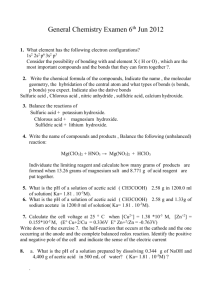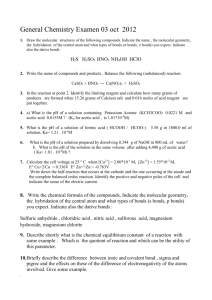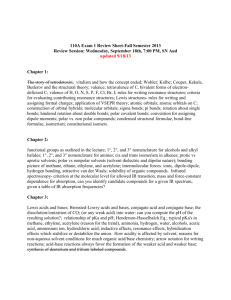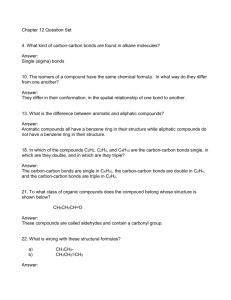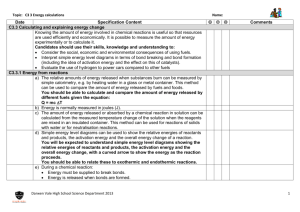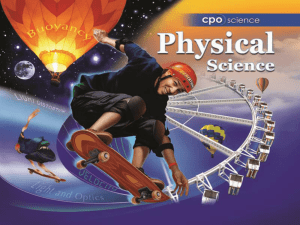Notes #1
advertisement
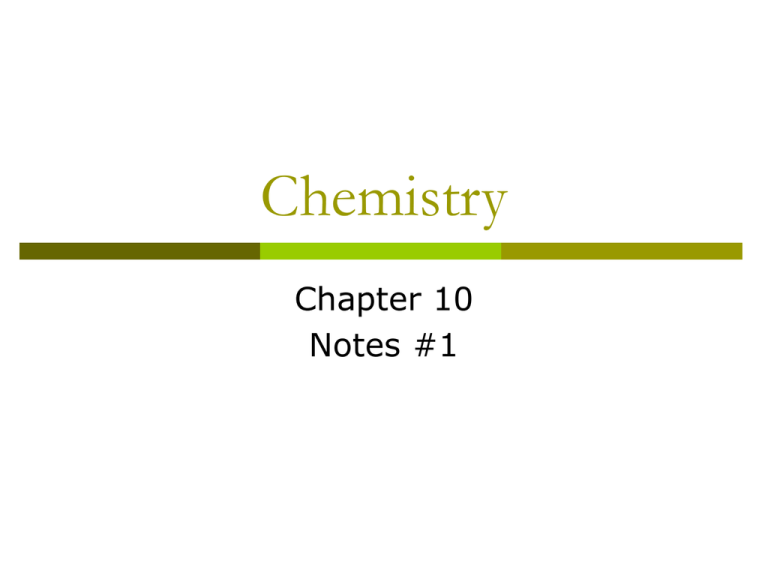
Chemistry Chapter 10 Notes #1 Covalent Compounds -Review Common Diatomic molecules Acids – Binary and Oxy Hydrogen (gas), Oxygen, Nitrogen, Fluorine, Chlorine, Bromine, Iodine Hydrochloric, Hydrosulfuric, Sulfuric, Sulfurous, Chlorous Regular Compounds Carbon Dioxide, Carbon tetrachloride, diphosphorus pentoxide Covalent Compounds Nonmetal + nonmetal Use prefixes to tell how many of each (find it on the pink sheet) 2nd element, change the ending to –ide Example Fluorine becomes Fluoride Example: CO2 - Carbon Dioxide Example: N2O4 – dinitrogen tetraoxide Ionic Compounds - Review Cation + Anion (positive + negative) Charges matter!!!!!! Roman numerals tell charge for transitions Polyatomics don’t end in –ide (mostly) Need your cheat sheet Examples Tin (IV) oxide, lead (II) sulfite, strontium carbonate, aluminum oxide, magnesium chloride, calcium oxide, potassium iodide, potassium iodate Ionic Compounds Metal + nonmetal Find charge on periodic table for elements, on pink sheet for polyatomics Ions come together to balance charge NO charges (superscripts) in the formulas, just subscripts EX: Mg2+ and Cl= MgCl2 Name: Name the metal, change the nonmetal ending to –ide EX: MgCl2 = Magnesium Chloride Chemical Reactions- Review Change in the composition and properties of a substance, or substances, as the result of a chemical reaction. Ex. Souring of Milk Ex. Rusting of iron Ex. Change in color Burning./Combustion Chemical reactions change substances Chemical Reactions- Review Signs of Chemical Change Combustion (Flame, Smoke, Ash) New substance formed Color change Precipitate (solid formed when mixing 2 liquids) Bubbling/fizzing (Production of a gas) Change in Temp (warmer or cooler) Disappearance of a metal Formation of liquid droplets Odor Reactions Breaking bonds require energy Forming bonds releases energy 2 terms for describing the overall energy transfer in a chemical reaction Exothermic Endothermic Reactions Chemical Reactions Exothermic Reactions Chemical reactions that overall release energy They use energy to break bonds, but more energy is released in the formation of the products than was used to break the bonds •Endothermic Reactions •Chemical reactions that overall use energy •They use more energy to break bonds than is released in the formation of the products Chemical Reactions Exothermic Endothermic Chemical Reactions Original bonds are broken Atoms rearrange New bonds form Reactants: starting substances that will undergo a chemical change Product: substance that is the result of a chemical change/reaction Chemical Reactions Energy is conserved in chemical reactions Law of conservation of energy Chemical energy – energy stored in the bonds of the compounds Total energy on the reactant side of an equation equals the total energy on the product side This includes the energy given off…. Chemical Reactions Reactants Word Equation Isooctane + oxygen Products -> carbon dioxide + water Skeleton Equation -> C8H18 + O2 -> CO2 + H2O Chemical Equation 2C8H18 + 25O2 -> 16CO2 + 18H2O Chemical Reactions In a balanced chemical equation energy and mass is conserved You can only change coefficients NO CHANGING SUBCRIPTS! Changing the subscripts changes the chemicals, therefore it changes the entire reaction Changing coefficients is just changing the amounts of chemicals necessary to carry out the reaction


